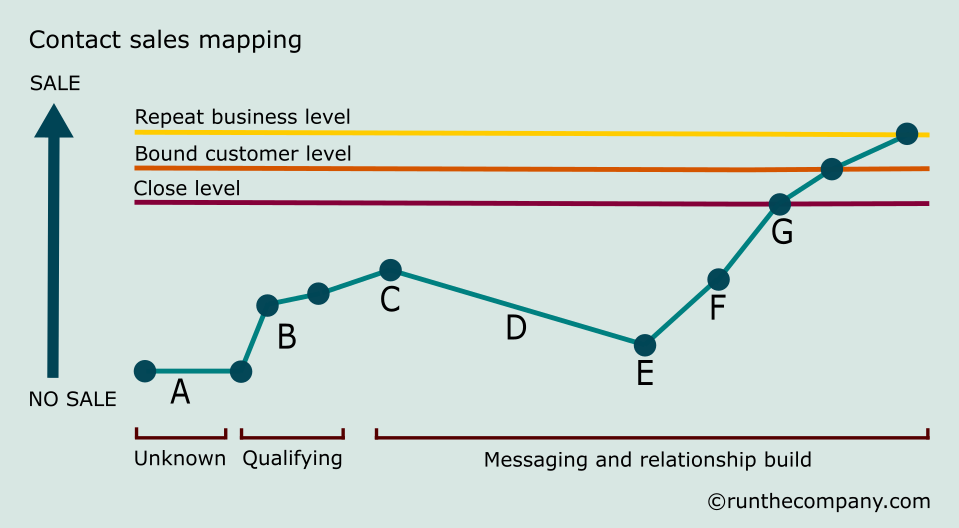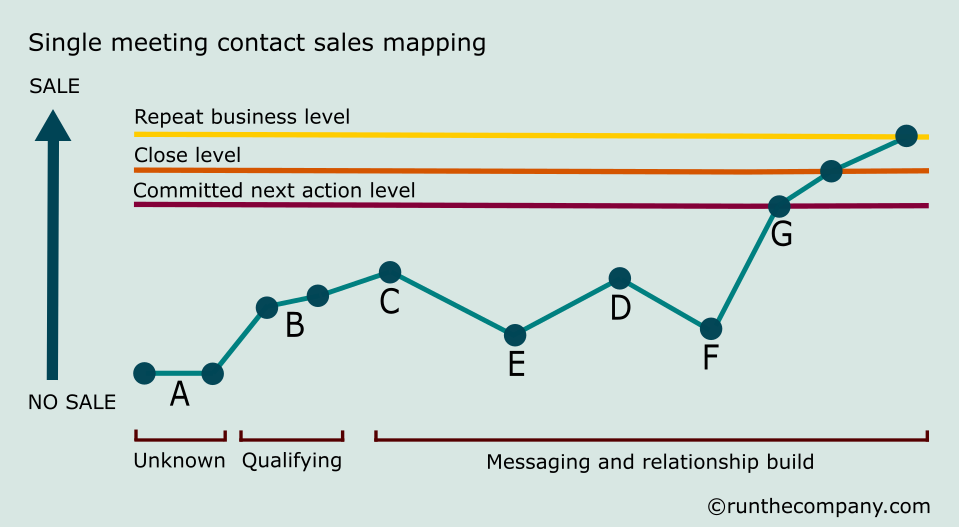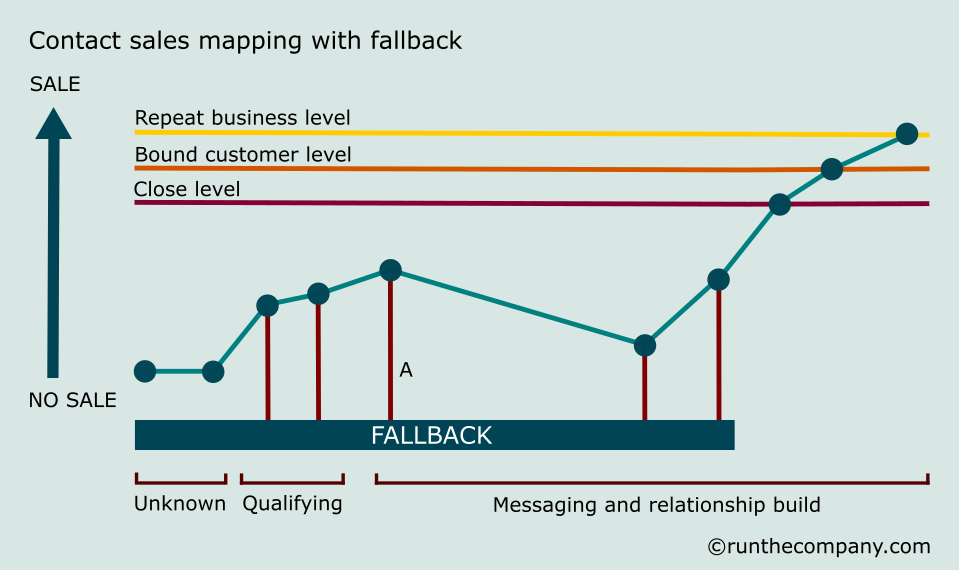Contact Sales Mapping

Selling that delivers good profit should not depend on luck or a fanciful dependence on fairy dust.
Having a structured and planned approach to the interaction of your business with your prospects will enable your sales function to be more efficient. This means more profitable sales delivered for the same outlay of time, effort and distraction.
You will also gain greater insight and control into what is really going on.
This is the logic and potency of Contact Sales Mapping.
Let’s take a look at the broad variables involved when making contact with other human beings in order to give them something in return for money from their pocket.
Types of sale
Single contact closing – example: Retail selling to members of the public (consumers).
Multiple contact – example: Business-to-business (businesses selling to other businesses).
For each type of sale, the prospect is taken on a journey.
This may all be done in one or two meetings as with retail or multiple meetings as with the development of the relationship to the “close” as with business-to-business selling.
Passive selling v proactive selling
Some people simply stand next to a row of jeans in the shop or answer the phone to answer questions and take the order.
Often they are called sales people but in fact they are order takers. The sale was already drifting past or coming in.
They were simply the conduit to administer the process. To obtain an order coming in their direction they simply had to passively do nothing wrong. This section considers proactive selling.
This means that without the effort taken by the individual to steer events to a “close” then the sale would not have come to your business.
Keeping your powder dry
Avoid the mistake of firing off all the propositions as to why the prospect should buy from you in one rapid fire machine gun blast. Selling is more like a series of carefully timed rifle shots.
Each proposition must be released in a particular order and at a pace for the prospect to constructively consider why they should want what you have to offer.
Keeping additional propositions you have under your belt and releasing them at your convenience will provide you with the facility to take the prospect on a journey. It is in taking this approach that you have the advantage.
Consider the Estate Agent analogy and the advantage over the home-seeking prospect of knowing what is behind each door in the house. The Estate Agent will lead the prospect through each room and communicate timed proportions as to why this is a good property to purchase. A good Estate Agent will hold the most appealing feature until the end. In other words, it is about getting the propositions in the right order then releasing them at the most potent moments in time.
Summary of typical prospect journeys – business-to-business
Two levels of journey
There are two levels of journey the prospect will undertake.
The Macro journey provides the cumulative experience the prospect gathers during its encounter with your business.
The Micro journey is the messaging and mini thoughts the prospect will experience and undertake within each encounter.
Macro journey – contact to close mapping
These are the nodes of contact the prospect encounters during the journey from not knowing who you are to being a long-term loyal customer.
This example is based on a business-to-business encounter over a period of time.

At each point of contact, there is either the opportunity to guide the prospect towards the close or turn positive any buying fears the prospect may have.
Interpretation of the structured sales strategy map above:
Unknown A:
Starting at the left side of the graph at A, you are unknown to the prospect, so the chance of a sale is limited.
This state will continue until you do something about it.
Nodes near B:
You are communicating with the prospect.
You start with Qualifying. This means you have to find out:
- If this prospect is going to buy now or define why not buy now.
- If this prospect is going to buy at a pre-determined point in the future and why.
- Find out why never buy or never buy from you.
This is done by finding out what the prospect wants or thinks he or she wants.
It’s important to also discover “why” he or she wants it.
If the prospect remains active (qualified to still be a buyer) then the qualification process should also be working in the positive (moving towards the sale and the close).
Hence the node movement towards the top of the graph.
The line D:
The prospect may drop from Node C to Node E – directing the journey towards a no-sale either because you have said or done something wrong or the prospect clarifies in their mind a fear for not buying; a competitor might have even had a say in proceedings.
Know that every sales process has to sustain the fear factor to some degree. The fear factor may delay a decision to buy, destroy the sale or simply be a minor bump in the road. The fear is one of conviction, vulnerability, the tangle of opportunity cost (what else to do with the money) or simply the fear of making a mistake.
Often there are invisible influencers you may not be aware of: other players within your target company that are having a say without you having a chance to meet and sell to them. This explains why a meeting goes well and you leave the premises convinced the sale is in the bag then at the next meeting the frosty encounter is tangible: someone has got at your prospect.
And sometimes the prospect is simply working you over for a better deal.
In this case the line D is extra long, indicating that too much time as passed and the contact is cooling off.
What you then do at the next node (Node E) is recover the situation and get things back on track.
Node G:
After meetings at points E and F, the process gets across the line to the close at point G.
You then start working on binding the account into your business and putting a moat around this customer to protect repeat business.
In other words, once the close is achieved then the real work begins. This is because the cost and effort of achieving a single sale is often not conducive to an optimum sales function (see achieving scaleable sales below).
Simple rules for contact nodes
Using contact nodes to develop the relationship and direct the journey towards the close depends on four things.
- The promise of value: solution/s to problems or desires.
- Alleviating fears of buying.
- Using each contact with the prospect to provide a piece of information or benefit that the prospect is pleased to have received. A piece of relevant value.
- Be liked.
If you always have a reason of relevant value to contact the prospect then they will take your call or be happy to meet with you. This is because they know they are always better off for having spoken to you. This and being pleasant to talk to is the mechanics of early business relationship development.
If you are always simply phoning to chase the progress of a decision then they may pretend to be out. The prospect is not interested in reassuring potential suppliers. They have enough to do in reassuring their bosses (their customers, employers, investors, the bank).
Momentum and its decay
Contact nodes should guide, motivate and create momentum towards the close. The time between nodes of contact often exposes your work to other influencers and distractions for your prospect.
Thinking without you around to counter any reservations will also create a natural slowing of the process.
Obtaining and owning strong Next Actions
Commitment to next actions and dates are useful to both guide the process and keep things on track.
However, the time between nodes when an agreed next action is being undertaken is still the weak link in the process.
Many Maybes (those that promise and hardly deliver) use agreed next actions as exit doors out of the immediate proceedings.
Strong next actions therefore require agreed commitment from the prospect. If a prospect fails to participate with a next action then this reverts back to the qualifying process. The prospect may not be right for you or the prospect is not ready to buy now. Confirm a later contact date and move on.
A good dose of reality may save a lot of wasted and costly effort.
Remember: reality delivers profits, optimism fuels forecasts.
The substance of each node and the order in which they are presented provide options in developing the most effective approach. Logging progress is important in that you will soon find the best formula for success.
At least attempting this approach will provide a deeper understanding of what is going on.
Achieving scaleable sales
The time and effort in sales and marketing to achieve a sale is likely to be disproportionate to achieving an optimum performing sales function.
Two points of scalable growth of sales where initial effort becomes more cost-effective
- Repeat business.
- Word of mouth or growth by recommendation (contributing to brand reputation).
In other words, your sales function must achieve three things.
- Sell the product.
- Bind the account for repeat business.
- Generate a positive reputation that can travel word-of-mouth.
Micro journey contact – the prospect’s journey within a meeting
A typical example would be retail where a sale may depend on some form of interaction between the prospect and the shop assistant.
Although agendas within business-to-business meetings and boardrooms will often have similar patterns.
Qualify
Proposition chain
Next action – commitment or close

Interpretation of the structured sales single meet map above:
All the nodes in this example appear within a single meeting and each represents a comment or demonstration within a single discussion between the sales person and the prospect.
Unknown A:
Starting at the left side of the graph at A, the prospect may be unaware of what you intend for this meeting. This state will continue until you change this at a time of your choosing.
Nodes near B:
You start Qualifying the prospect from the perspective of this meeting’s objectives.
C to E:
Nodes will naturally fluctuate towards and away from a sale due to prospect fears and you alleviating those fears. A meeting without questions, reservations or concerns expressed by the prospect often means a zombie encounter and that means a never-ending maybe or no-sale.
D to F then G:
A sign of reservation or a pause from the prospect just before the close is a natural position to take before a commitment is made. Be aware of this and work it to your favour. Know when to take an action or give space for the decision to be made.
The Fallback
If good reasons for a no-sale emerge or that the timing to buy is not now then rather than simply say goodbye to the prospect, you should still make the call or meeting more cost effective by going to the Fallback.
The Fallback is not a selling task but rather an information gathering task.
In a business-to-business situation, enter any gathered information into the CRM (Customer Relationship Management) data system. This market intelligence will help evolve the tasks and could provide valuable insight for your next call.
Typical information gathered at Fallback
- Why was the prospect not interested?
- Is the prospect buying from someone else – and why?
- News on competition activity and strategy.
- Market issues.
- Any specific issues regarding the product or service.
Contact nodes and the move to Fallback

The vertical red lines typically highlighted at A, demonstrate that you can revert to the Fallback at any time in the process.


